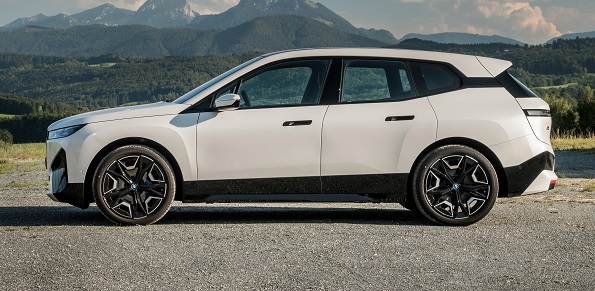Key specs
BMW iX (SAV) iX 2021,2022,2023,2024,2025,2026
What is the body type, BMW iX xDrive40 76.6 kWh (326 Hp) 2021?
SAV, 5 Doors, 5 Seats
How fast is the car, BMW iX xDrive40 76.6 kWh (326 Hp) 2021?
200 km/h, Electronically limited 124.27 mph
How many cylinders, BMW iX xDrive40 76.6 kWh (326 Hp) 2021?
Electric,
What is the drivetrain, BMW iX xDrive40 76.6 kWh (326 Hp) 2021?
All wheel drive (4x4),
How long is this vehicle, BMW iX xDrive40 76.6 kWh (326 Hp) 2021?
4953 mm
195 in.
How wide is the vehicle, BMW iX xDrive40 76.6 kWh (326 Hp) 2021?
1967 mm
77.44 in.
What is the curb weight, BMW iX xDrive40 76.6 kWh (326 Hp) 2021?
2365 kg
5213.93 lbs.
BMW iX (SAV) iX 2021,2022,2023,2024,2025,2026 Specs
General information
| Brand |
BMW |
| Model |
iX (SAV) |
| Version |
iX |
| Engine version |
xDrive40 76.6 kWh (326 Hp) |
| Year production start |
2021 |
| Vehicle type |
SAV |
| Acceleration 0 - 100 kmh sec |
6.1 sec |
| Curb weight kg -lbs total |
2365 kg
5213.93 lbs.
|
| Overall length mm - inch |
4953 mm
195 in.
|
| Doors |
5 |
| Top Speed |
200 km/h, Electronically limited 124.27 mph |
Engine specs
| Engine position and orientation |
Front axle, Transverse |
| Cylinders |
Electric |
| Weight / horsepower kg/hp - hp/tons |
7.3 kg/Hp
137.8 Hp/tonne
|
| Weight / torque kg/Nm - Nm/tons |
3.8 kg/Nm, 266.4 Nm/tonne
3.8 kg/Nm
266.4 Nm/tonne
|
| Fuel type |
Electricity |
| Powertrain architecture |
BEV (Electric Vehicle) |
| Electric motor power |
272 Hp
|
| Electric motor torque |
352 Nm 259.62 lb.-ft.
|
| Engine location |
Front axle, Transverse
|
| Total available power |
326 Hp
|
| Totale available torque |
630 Nm 464.66 lb.-ft.
|
Transmission and Drive system
| Drive configuration |
All wheel drive (4x4)
|
Brakes
| Front brakes |
Ventilated discs, 348x30 mm |
| Rear brakes |
Ventilated discs, 348x30 mm |
| Brake control |
Ventilated discs, 330x20 mm |
| Anti-lock brake system |
ABS (Anti-lock braking system) |
Steering
| Steering type |
Steering rack and pinion |
| Turning diameter m - ft |
12.8 m
41.99 ft.
|
Suspension
| Front suspension |
Double wishbone |
| Rear suspension |
Independent multi-link |
Wheels & Tyres
| Wheels size |
235/60 R20
|
| Wheels rims |
8.5J x 20 |
Passenger
| Passengers seats |
5 |
| Trunk space min liter | cu. Ft. |
500 l
17.66 cu. ft.
|
| Trunk space max liter | cu. Ft. |
1750 l
61.8 cu. ft.
|
| Roof load load kg lbs |
75 kg
165.35 lbs.
|
Dimensions
| Overall length mm - inch |
4953 mm
195 in.
|
| Overall width mm -inch |
1967 mm
77.44 in.
|
| Overall height mm -inch |
1695 mm
66.73 in.
|
| Wheelbase mm - inch |
3000 mm
118.11 in.
|
| Track width front mm - inch |
1679 mm
66.1 in.
|
| Track width rear mm - inch |
1709 mm
67.28 in.
|
| Coefficient of drag |
0.25
|
Weights
| Curb weight kg -lbs total |
2365 kg
5213.93 lbs.
|
| Gross weight kg -lbs total |
3010 kg
6635.91 lbs.
|
| Capacities kg - lbs |
645 kg
1421.98 lbs.
|
Engine type
Electric
https://www.thecarspec.com/components/engine/electric

